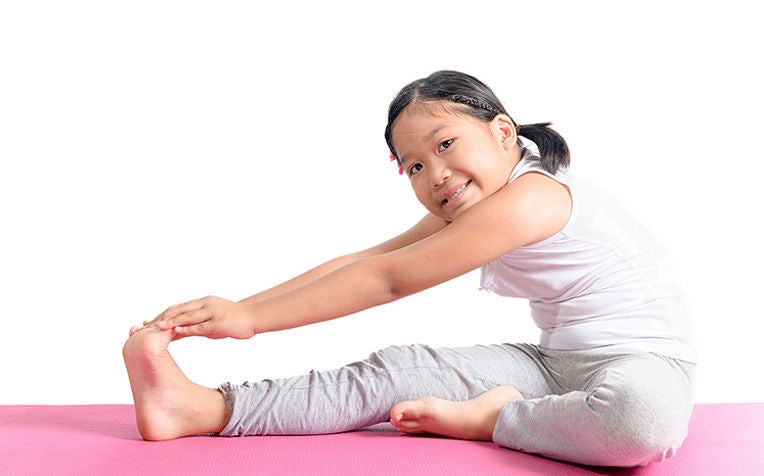
(Active) Lower limb stretching exercises help to maintain flexibility or range of movement in the lower limb joints.
Stretching exercises or range of motion (ROM) exercises are important to maintain flexibility or range of movement in the lower limb joints. It also assists with overall circulation and creates awareness of lower limbs.
The following exercises serve as a guide to the various stretches of the lower limb. Do ensure that you have been taught the recommended exercises and exercise regime (i.e. number of repetitions / sets and exercise frequency) by your child’s Physiotherapist before carrying them out.
Safety precautions when exercising
Ensure your child is positioned comfortably
Keep your movements slow to allow muscles to relax; moving quickly may increase stiffness
Do not force the movement if the muscle or joint is stiff – move the joint within the safe range as recommended by your therapist
Observe for signs of pain or discomfort – stop if pain occurs, and check in with your therapist before continuing further
Your exercise regime
![]() Each stretching exercise should be repeated
5-10 times
Each stretching exercise should be repeated
5-10 times
![]() Hold the stretch at the end for
20-30 seconds
Hold the stretch at the end for
20-30 seconds
![]() Repeat exercises
every day – check in with your therapist on the recommended number of sets per day
Repeat exercises
every day – check in with your therapist on the recommended number of sets per day
Active stretches
Hip | |
Hip flexor stretch Aim: To stretch or maintain range in your hips and trunk. Instruction: Position yourself lying on your stomach with your upper body supported through your elbows. Raise your chest off the bed by pushing through your hands to straighten your elbows. |
/hip-flexor-stretch.jpg)
|
Hip adductor stretch Aim: To stretch or maintain length of tight tissue over the inner thigh muscles Instruction: Position yourself sitting with your hips and knees bent to each side and your feet together. Let your knees drop to the floor and sustain the position by leaning your body forwards. Change your position so that you receive maximal stretch over the inner thighs. Precautions: Take care when stretching tight muscles around the inner thigh as excessive stretch or overpressure may cause excessive strain. Stop the exercise and check with your physiotherapist if you are experiencing pain during the stretch. |
/hip-adductor-stretch.jpg)
|
Knee | |
Seated hamstring stretch Aim: To stretch or maintain length in the muscles at the back of your thighs. Instructions: Position yourself sitting with one leg out straight in front of you. Keep your back straight and lean forwards at your hips |
/seated-hamstring-stretch.jpg)
|
Hamstring stretch with towel Aim: To stretch or maintain length in the muscles at the back of your thighs. Instructions: Position yourself lying on your back with your hip bent and knee straight and the arch of your foot hooked on a towel. Ensure your knee remains straight as you pull the towel towards your chest. |
/hamstring-stretch-with-towel.jpg)
|
Ankle | |
Standing gastrocnemius stretch (A) Aim: To stretch or maintain range in your calf muscles. Instructions: Position yourself standing with one leg in front of the other and your hands resting on a wall. Lunge forwards while keeping your back leg straight. Ensure that both feet point forwards, and your back heel remains on the ground. Lean forward until the stretch is felt at the calf. |
/standing-gastrocnemius-stretch-a.jpg)
|
Standing gastrocnemius stretch (B) Aim: To stretch or maintain range of your calf muscles.
Instructions: Position yourself standing over a step or stair while holding onto a stable surface. Ensure that both feet point forwards with your knees straight, and gently lower your heel down from the step until a stretch is felt at the calves. |
/standing-gastrocnemius-stretch-b1.jpg)
|
Seated gastrocnemius stretch Aim: To stretch or maintain range of your calf muscles. Instructions: Sit upright with your hips and knees bent, use a towel to hook onto the arch of your foot. You may lean against a wall if necessary. Ensure your knee remains straight as you pull the towel towards your head. |
/seated-gastrocnemius-stretch.jpg)
|
Standing soleus stretch Aim: To stretch or maintain range of your calf muscles. Instructions: Position yourself standing with one leg in front of the other and your hands resting on a wall. Keep both of your knees bent. Ensure that both feet point forward, and your back heel remains on the ground. |
|
Seated soleus stretch Aim: To stretch or maintain range of your calf muscles. Instructions: Sit upright with your hips and knees bent, use a towel to hook onto the arch of your foot. You may lean against a wall if necessary. Ensure your knee remains bent as your pull the towel towards your head. |
/seated-soleus-stretch-b.jpg)
|
Ref: K21
Check out other articles on seizure and epilepsy in children:
Epilepsy and Seizures: Causes, Types and How to Manage
Seizure and Epilepsy Action Plan
Epilepsy: Treatment and Diet Tips
Child Neurological Conditions: Care Tips Resource












/standing-soleus-stretch-b.jpg)





 Get it on Google Play
Get it on Google Play